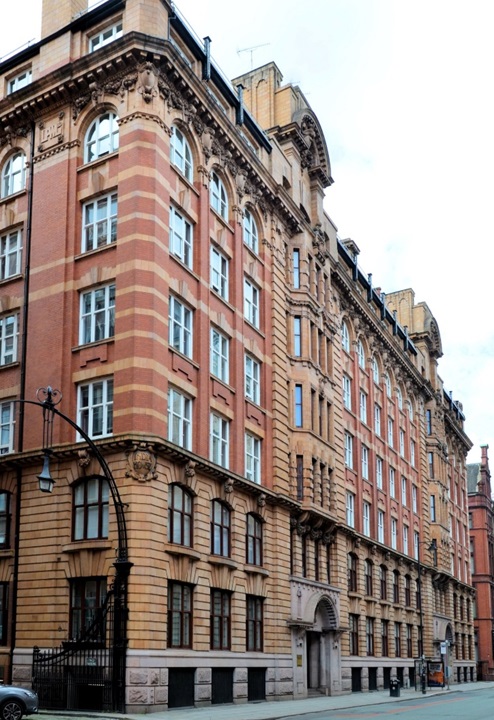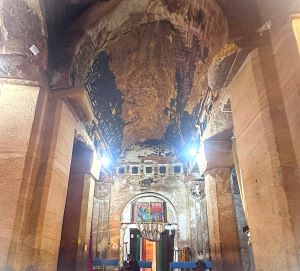M Womersleys carried out mortar analysis on the building and pointing mortars used externally at a higher level at India House
M Womersleys carried out mortar analysis on the building and pointing mortars used externally at a higher level at India House on Whitworth Street in Manchester. This allowed restoration work to this historically significant and Grade II* listed building to be assessed.

The design of India House, featuring a seven-story building adorned with striking Baroque detailing, was the first significant commission received by Harry S. Fairhurst and was completed in 1905. The design showcases a symmetrical elevation with two entrance bays topped by ornate gables. The composition combines a rusticated base formed by the basement and the first two stories with a distinct main order comprising the following four stories. Above the cornice, a further story is embellished with additional decorative elements.
The building features an internal steel framework encased in concrete. The elevation facing Whitworth Street is executed in red brick and terracotta, resting on a base of Aberdeen Correnie granite. The two main entrances feature granite steps and faience walls with circular vaulted ceilings. Inside, mahogany columns and pilasters adorn the halls, while all doors on the economically designed short landings are crafted from mahogany.
In contrast, the rear elevation lacks historical embellishments and features large windows integrated into the steel frame's pattern, giving it a functional and modern appearance. Fairhurst also designed internal demountable partitions to allow for flexible rearrangement of office spaces. The Manchester Group of the Victorian Society sees India House as the culmination of 19th-century warehouse design. (Northern Counties Housing Association converted India House in 1989 into 100 residential apartments available for rent, and extensive maintenance works were undertaken after 2020. )
As expected in a building at the forefront of modern 20th-century design, the mortars used to bed the terracotta and granite were either bound by moderately hydraulic lime or earlier natural cement or OPCs. Mixes of one part hydraulic lime, natural cement, or earlier ordinary Portland cement, and two parts sand are suggested in the elementary edition of Mitchell's Building Construction book, published in the same year as the India house was built.
M Womersleys carried out a comprehensive mortar dissolution analysis on seven samples to determine the composition and properties of lime and early cement-bound mortar samples, particularly to assess the type and amount of lime present and any other materials used in the mix (such as sand, aggregates, and additives). This meticulous analysis is critical to ensure compatible replacement mortars are used for restoration projects in historic buildings, demonstrating our commitment to a thorough and accurate restoration process.
The mortar samples were collected from areas near the top of the building in the area of interest. After an initial drying process, we visually inspected the samples, noting the mortar's colour, texture, and condition. We looked with the naked eye and through a microscope to assess the granulation and composite structure of the mortar.
The samples were then accurately weighed using an analytical balance. Diluted Hydrochloric and Hexafluorosilicic acids were used to avoid overly rapid reactions that can complicate analysis. The mortar samples were placed in a beaker containing the prepared acid solution. The solution was sufficient to cover the sample completely. The contents were gently stirred to facilitate the dissolution of the lime content and allowed to sit in the solution for several hours to ensure complete dissolution of the alkaline and base elements. The amount of fizzing or bubbling was observed, indicating the concentration of free lime in the samples as the lime dissolves.
After the dissolution period, the solution was filtered to separate any undissolved material from the dissolved lime, and the residue was rinsed with distilled water to remove any salts created in the reaction. The solid residue collected on the filter paper was then dried slowly.
The remaining solid residues were weighed to determine the undissolved portion and run through a series of sieves to determine the particle size distribution. Each sieve within a stack of diminishing sieves had its contents weighed and examined under a microscope to determine the amount and type of undissolved binder and the types of aggregate grains in the residue for that sieve size. The data gathered from the dissolution analysis to ascertain the lime content, types of aggregates, ratios, and any additional materials present was then correlated by M Womersleys with historical information about the building, and a summary of the results and what they meant was provided. If an advanced analysis is desired, we can arrange for the mortar to be sent to a laboratory for further chemical analysis, such as X-ray fluorescence (XRF) to determine the elemental composition or Thermogravimetric analysis (TGA) to assess weight loss at different temperatures that might reflect the presence of various phases of hydraulic limes and carbonates.
Conclusion
Lime or early cement mortar dissolution analysis is a valuable tool for assessing the composition of historic mortars. Contractors and professionals can obtain critical insights to inform restoration and conservation efforts and ensure that the mortars used in restoration work are not too strong or weak for the original built fabric and its earlier bedding mortars.
Useful References
- Historic England, "India House (including attached wrought iron gateway linked to Lancaster House) (1254836)", National Heritage List for England
- Manchester Guardian 22 March 1907 page 10
- British Architect 27 March 1907
- RIBA Drawings: RAN/10/K51 Foundation Plan (1905) RAN/10/K54 Elevation to Whitworth Street.
- The Manchester Group of the Victorian Society.
- https://manchestervictorianarchitects.org.uk/buildings/india-house-whitworth-street-manchester
Related Articles

On Sunday, March 16th, why not come for a full introduction to lime plastering and a practical demonstration workshop?
Learn more about traditional clay, lime, and ornamental gypsum plasters and their use internationally…

Proposals to carry out a conservation assessment at Wukro Cherkos, with a full training programme for recent graduates from Mekelle University and government bodies responsible for regional conservation work.
Introduction In response to continued concerns about the condition of one of Tigray’s most well…

Report on the support given by M Womersleys to Jabir Mohamed at Berbera Museum, Berbera, Somaliland, over two weeks from the end of October 2024
Contents …